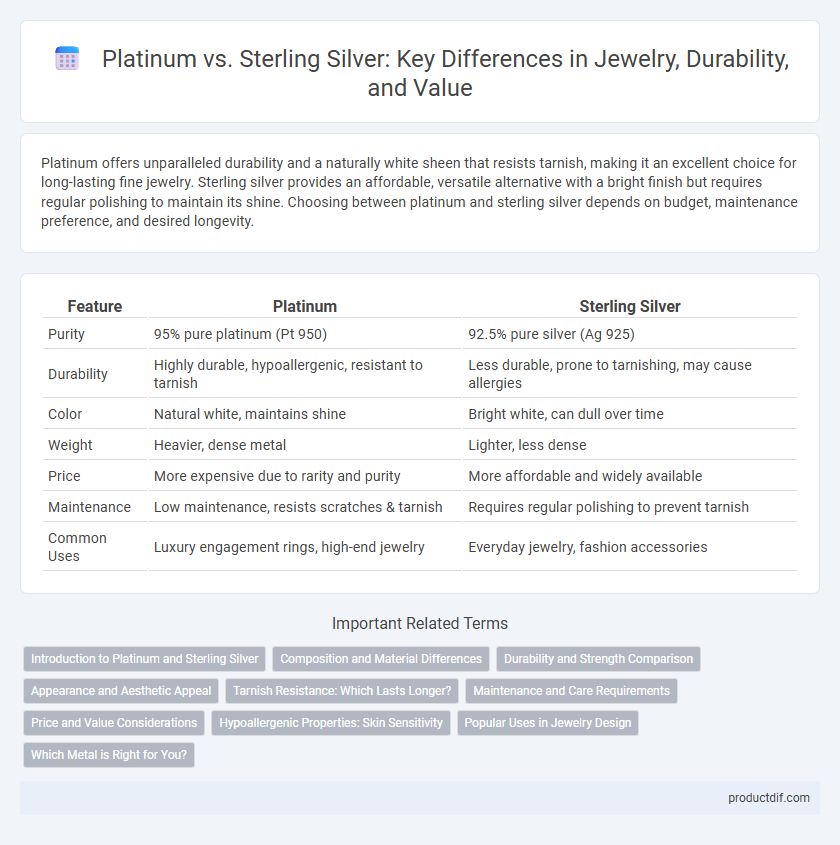Platinum offers unparalleled durability and a naturally white sheen that resists tarnish, making it an excellent choice for long-lasting fine jewelry. Sterling silver provides an affordable, versatile alternative with a bright finish but requires regular polishing to maintain its shine. Choosing between platinum and sterling silver depends on budget, maintenance preference, and desired longevity.
Table of Comparison
| Feature | Platinum | Sterling Silver |
|---|---|---|
| Purity | 95% pure platinum (Pt 950) | 92.5% pure silver (Ag 925) |
| Durability | Highly durable, hypoallergenic, resistant to tarnish | Less durable, prone to tarnishing, may cause allergies |
| Color | Natural white, maintains shine | Bright white, can dull over time |
| Weight | Heavier, dense metal | Lighter, less dense |
| Price | More expensive due to rarity and purity | More affordable and widely available |
| Maintenance | Low maintenance, resists scratches & tarnish | Requires regular polishing to prevent tarnish |
| Common Uses | Luxury engagement rings, high-end jewelry | Everyday jewelry, fashion accessories |
Introduction to Platinum and Sterling Silver
Platinum is a naturally white, dense metal known for its durability and resistance to tarnish, making it a premium choice in fine jewelry. Sterling silver consists of 92.5% pure silver alloyed with other metals, offering a bright sheen and affordability but requiring regular maintenance to prevent tarnishing. Both metals serve distinct purposes in jewelry making, catering to different preferences and budgets.
Composition and Material Differences
Platinum is a naturally white precious metal composed of 95% pure platinum, known for its durability, density, and resistance to tarnish, making it highly hypoallergenic. Sterling silver consists of 92.5% pure silver alloyed primarily with copper, which enhances its strength but can cause tarnishing over time. The higher purity and density of platinum result in a more substantial weight and greater resistance to scratching compared to sterling silver.
Durability and Strength Comparison
Platinum is renowned for its exceptional durability and strength, making it highly resistant to scratches and tarnish compared to sterling silver, which is softer and prone to oxidation over time. The dense molecular structure of platinum allows it to maintain its shape and luster even with daily wear, offering superior longevity for fine jewelry pieces. Sterling silver requires more frequent polishing and careful handling to avoid damage, while platinum jewelry often withstands harsher conditions without significant wear.
Appearance and Aesthetic Appeal
Platinum jewelry exhibits a naturally bright white sheen that resists tarnish, maintaining its lustrous and luxurious appearance over time. Sterling silver offers a shiny, reflective surface with a slightly warmer tone but requires regular polishing to prevent oxidation and dullness. The denser composition of platinum provides a heavier feel and a more substantial presence compared to the lighter, more affordable sterling silver pieces.
Tarnish Resistance: Which Lasts Longer?
Platinum offers superior tarnish resistance compared to sterling silver, maintaining its shine and luster over many years without requiring frequent polishing. Sterling silver, composed of 92.5% silver and typically mixed with copper, tends to tarnish more quickly due to oxidation and exposure to air and moisture. Investing in platinum jewelry ensures long-lasting durability and minimal maintenance, ideal for those seeking timeless, tarnish-free pieces.
Maintenance and Care Requirements
Platinum jewelry requires less frequent polishing due to its natural resistance to tarnish and corrosion, making it low-maintenance for long-term wear. Sterling silver needs regular cleaning and careful storage to prevent oxidation and tarnishing, often requiring polishing cloths or solutions to maintain its shine. Both metals benefit from avoiding harsh chemicals and abrasive materials, but platinum offers greater durability and less upkeep overall.
Price and Value Considerations
Platinum jewelry typically commands a higher price due to its greater density, durability, and rarity compared to sterling silver. Sterling silver offers an affordable alternative with a bright appearance but is more prone to tarnishing and wear over time. Investing in platinum provides long-term value through enhanced resilience and hypoallergenic properties, making it ideal for heirloom pieces.
Hypoallergenic Properties: Skin Sensitivity
Platinum is highly prized for its hypoallergenic properties, making it an excellent choice for individuals with sensitive skin or metal allergies. Sterling silver, while popular and affordable, often contains trace amounts of nickel or other metals that can cause irritation or allergic reactions. Choosing platinum ensures a safer and more comfortable wear for those prone to skin sensitivity.
Popular Uses in Jewelry Design
Platinum is prized in high-end jewelry for its durability, natural white sheen, and resistance to tarnish, commonly used in engagement rings, wedding bands, and luxury timepieces. Sterling silver is favored for its affordability and versatility, widely employed in fashion jewelry, intricate designs, and statement pieces. Both metals offer distinct aesthetics and functionality, influencing their popularity in fine versus everyday jewelry collections.
Which Metal is Right for You?
Platinum offers exceptional durability and hypoallergenic properties, making it ideal for those with sensitive skin or individuals seeking long-lasting, premium jewelry. Sterling silver provides an affordable, versatile option with a bright luster but requires regular maintenance to prevent tarnish. Choose platinum for investment pieces and daily wear, while sterling silver suits budget-conscious buyers wanting stylish, occasional-use accessories.
Platinum vs Sterling Silver Infographic

 productdif.com
productdif.com